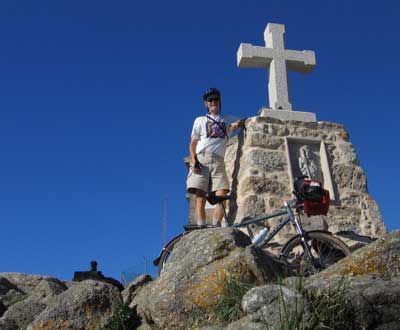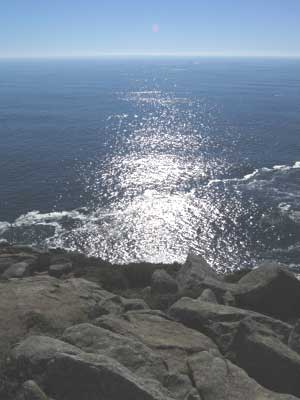
September 27, 2004

With only half the normal weight of luggage (I’d left one saddlebag in Santiago), and having already achieved the major goal of reaching Santiago de Compostella intact, the ride out to the Atlantic coast at Finisterre was a treat. The gift of another pair of sunny days (I have been amazingly fortunate with weather the entire journey), and I was heading to the coast again: what’s not to like?
There is just one long climb of note along the way (about two thirds of the way to the coast) but it passes quickly, and as with all such climbs there is a fine descent as a reward on the hill’s far side. At this time of year the chestnut trees display their wares, the freshly polished nuts gleaming out at me from roadside in their bristly overcoats. I thought about gathering a bag full of them to bring home and roast in our Deep Cove winter fireplace (wouldn’t it be wonderful, I told myself, to harvest a small crop of these last days of my Spanish summer, and to dip into them at leisure when Vancouver’s rains descend again?); but before I knew it the chestnuts had given way to groves of eucalyptus trees, and the opportunity was lost. The sun warms the eucalyptus bark and leaves, and they release their evocative fragrance on the air: memories of Vick’s Vap-O-Rub, and the tender tending of my childhood colds; of another summer years ago, as I drove along the California coast with J; and a third, more recent summer when we explored the hills of Corsica together). These are among the pleasures of travelling by bicycle; the things that can be easily overlooked — or completely missed — when trapped inside a speeding car.
When I first spotted the Galician coastline I let out an involuntary whoop: coasting fast downhill, the wind shouting in my ears, eyes fixed on sunshiney glints from distant waves. I don’t think I’d fully realized how much a product of the coast I am. I have missed the tang of salt, the sound of water, and the regularity of the tides. This was a west coast too, of course, and would have similar sunsets, the same sense of an unbounded watery horizon, the same soothing wash of water on a rocky shore.
The Galician coast at Noia and north is exposed and rocky, with pockets of white sandy beaches, and small ports installed at irregular intervals along the road. The road is well-surfaced, and rolls gently along the coastline, climbing over each low headland and sliding down again to the next beach or port in line. All is essentially deserted now: the empty beaches stretch on and on in the late September sun, with only a scattering of locals to take advantage of this unseasonally fine still-summer weather. A pair of young mothers install themselves for the afternoon just below my lunch spot. Stripping down to one-piece black bathing suits they lounge on beach mats and talk in low Spanish voices, leafing through fashion magazines while their two small sons leap and splash in the soft surf together, repeatedly astonished — alert, alive — as the chilly water hits their hot skin.
After the crowded Camino, these two days riding along a quiet coastline were a vacation from my vacation. Not a single fellow peregrino is in sight. I stop and spend the night midway to Finisterre: at the port of Muros (a prettier choice would have been San Francisco, a further 5 km up the coast). In Muros it is de rigeur to stroll along the port’s seawall sidewalk while the sun extinguishes itself in the western sea, nibbling from a package of sunflower or pumpkin seeds still in shells. It seemed as if half the town was strolling thus, while the other half sat and watched them from cafés across the road. All of them — and me — waiting for the dinner hour. They strolled along in pairs or mixed quartets, talking, nibbling and spitting seed husks on the ground. I traced the seeds back to their source: a small newspaper kiosk tucked against the seawall walk, and bought myself a salty package in an unsuccessful attempt to blend in.
The next day was more of the same: more sun, more waves washing against the coast while I pedalled on. Just 60 km more to Finisterre. Stopping for coffee in one small village I lean my bicycle against the café wall, and as I do so the local madwoman is at my side as if by magic. Her eyes are wild and bright, and she asks a question I will never understand, and laughs aloud. She waits briefly for an answer before darting inside where she leans against the bar and sings fragments of a song before she’s off again, around a corner and forever gone. What did she want to know, I wonder? Were her words a blessing or a curse?

The albergue at Finisterre is one street up from the port. It is the now-familiar offering of spartan dorms and paperless toilet stalls, and it backs directly onto the bus turnaround where I will catch the morning bus to Santiago. As if these attractions were not enough to diminish demand, there is a notice posted that only those who make it to Finisterre under their own steam (on foot or bicycle) are permitted to stay. As I check in — my final Camino albergue — I am presented with another certificate of completion: the Fisterrana, which attests to the fact that I have at last reached what was once the end of the known world.
The Finisterre lighthouse is a further 3 km west of town, and I leave all my luggage beside my bunk before riding out to contemplate the end of this long and winding road. Just below the lighthouse is another monument — a bronze sculpture of a pair of broken boots — in memory of a pilgrim who drowned here in the late 1990s, as well as a final stone marker topped with a cross that marks the Camino’s official end (above).
Imagine how it must have been for the pilgrims of centuries before: before Columbus put another shore upon the far side of that sea. They would have walked for months through strange and foreign lands, over terrain far less hospitable than what I had dealt with in my mere month of travel. Tired and wiser, they would have stood where I stood now. They would have looked across that infinite western sea; and all the known world, everything that was familiar to them would have been behind.
In those days there was no quick way back: no train lines, no buses, and no airlines to lift the pilgrims up and transport them magically to their dispersed beginnings. The end of the Camino simply meant another long, hard journey: the journey home.
When you reach the end there is nowhere to go but back. And so the journey continues with a small series of backward steps — back to Santiago, and back to Paris — in preparation for a running leap into that future-void. A leap beyond present horizons to another western shore.

Postscript (a few statistics for the statistically-minded):
- 2281 km (1417 miles)
- 32 cycling days
- 4 rest days
- average 71 km per day
- 4 lbs lost weight
![]()
© 2004 Michael Hayward
« previous
::
The route
The bike
The 3 Ps: Preliminaries, Preparations and Packing
Dry run
Departure! (and contact info)
Books
Beginning to begin
Toulouse
Burgos
El Burgo Ranero
Advice
Villadangos del Paramo
Rabanal del Camino
Interlude: A New Philosophy
Villafranca del Bierzo
Approaching Santiago
Santiago de Compostella
The end of the earth